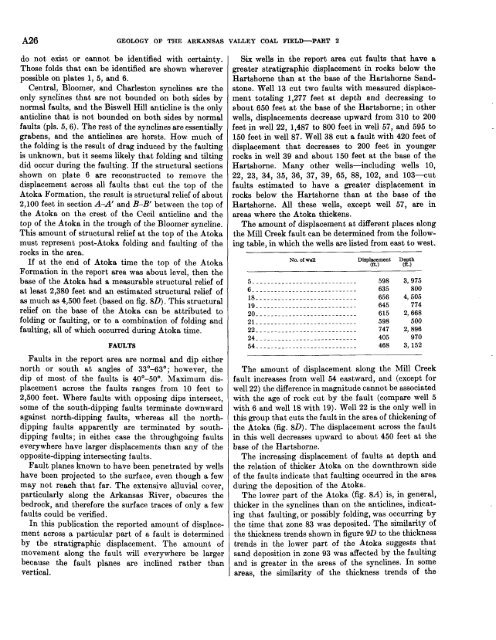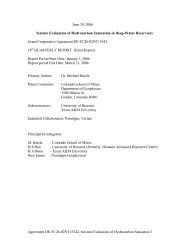Geology of the Van Buren and Lavaca Quadrangles, Arkansas ...
Geology of the Van Buren and Lavaca Quadrangles, Arkansas ...
Geology of the Van Buren and Lavaca Quadrangles, Arkansas ...
You also want an ePaper? Increase the reach of your titles
YUMPU automatically turns print PDFs into web optimized ePapers that Google loves.
A26 GEOLOGY OF THE ARKANSAS<br />
do not exist or cannot be identified with certainty.<br />
Those folds that can be identified are shown wherever<br />
possible on plates 1, 5, <strong>and</strong> 6.<br />
Central, Bloomer, <strong>and</strong> Charleston synclines are <strong>the</strong><br />
only synclines that are not bounded on both sides by<br />
normal faults, <strong>and</strong> <strong>the</strong> Biswell Hill anticline is <strong>the</strong> only<br />
anticline that is not bounded on both sides by normal<br />
faults (pls. 5,6). The rest <strong>of</strong> <strong>the</strong> synclines are essentially<br />
grabens, <strong>and</strong> <strong>the</strong> anticlines are horsts. How much <strong>of</strong><br />
<strong>the</strong> folding is <strong>the</strong> result <strong>of</strong> drag induced by <strong>the</strong> faulting<br />
is unknown, but it seems likely that folding <strong>and</strong> tilting<br />
did occur during <strong>the</strong> faulting. If <strong>the</strong> structural sections<br />
shown on plate 6 are reconstructed to remove <strong>the</strong><br />
displacement across all faults that cut <strong>the</strong> top <strong>of</strong> <strong>the</strong><br />
Atoka Formation, <strong>the</strong> result is structural relief <strong>of</strong> about<br />
2,100 feet in section A-A' <strong>and</strong> B-B' between <strong>the</strong> top <strong>of</strong><br />
<strong>the</strong> Atoka on <strong>the</strong> crest <strong>of</strong> <strong>the</strong> Cecil anticline <strong>and</strong> <strong>the</strong><br />
top <strong>of</strong> <strong>the</strong> Atoka in <strong>the</strong> trough <strong>of</strong> <strong>the</strong> Bloomer syncline.<br />
This amount <strong>of</strong> structural relief at <strong>the</strong> top <strong>of</strong> <strong>the</strong> Atoka<br />
must represent post-Atoka folding <strong>and</strong> faulting <strong>of</strong> <strong>the</strong><br />
rocks in <strong>the</strong> area.<br />
If at <strong>the</strong> end <strong>of</strong> Atoka time <strong>the</strong> top <strong>of</strong> <strong>the</strong> Atoka<br />
Formation in <strong>the</strong> report area was about level, <strong>the</strong>n <strong>the</strong><br />
base <strong>of</strong> <strong>the</strong> Atoka had a measurable structural relief <strong>of</strong><br />
at least 2,380 feet <strong>and</strong> an estimated structural relief <strong>of</strong><br />
as much as 4,500 feet (based on fig. 80). This structural<br />
relief on <strong>the</strong> base <strong>of</strong> <strong>the</strong> Atoka can be attributed to<br />
folding or faulting, or to a combination <strong>of</strong> folding <strong>and</strong><br />
faulting, all <strong>of</strong> which occurred during Atoka time.<br />
FAULTS<br />
Faults in <strong>the</strong> report area are normal <strong>and</strong> dip ei<strong>the</strong>r<br />
north or south at angles <strong>of</strong> 33'-63'; however, <strong>the</strong><br />
dip <strong>of</strong> most <strong>of</strong> <strong>the</strong> faults is 40'-50'. Maximum dis-<br />
placement across <strong>the</strong> faults ranges from 10 feet to<br />
2,500 feet. Where faults with opposing dips intersect,<br />
some <strong>of</strong> <strong>the</strong> south-dipping faults terminate downward<br />
against north-dipping faults, whereas all <strong>the</strong> north-<br />
dipping faults apparently are terminated by south-<br />
dipping faults; in ei<strong>the</strong>i case <strong>the</strong> throughgoing faults<br />
everywhere have larger displacements than any <strong>of</strong> <strong>the</strong><br />
opposite-dipping intersecting faults.<br />
Fault planes known to have been penetrated by wells<br />
have been projected to <strong>the</strong> surface, even though a few<br />
may not reach that far. The extensive alluvial cover,<br />
particularly along <strong>the</strong> <strong>Arkansas</strong> River, obscures <strong>the</strong><br />
bedrock, <strong>and</strong> <strong>the</strong>refore <strong>the</strong> surface traces <strong>of</strong> only a few<br />
faults could be verified.<br />
In this publication <strong>the</strong> reported amount <strong>of</strong> displace-<br />
ment across a particular part <strong>of</strong> a fault is determined<br />
by <strong>the</strong> stratigraphic displacement. The amount <strong>of</strong><br />
movement along <strong>the</strong> fault will everywhere be larger<br />
because <strong>the</strong> fault planes are inclined ra<strong>the</strong>r than<br />
vertical.<br />
ALLEY COAL FIEL-PART 2<br />
Six wells in <strong>the</strong> report area cut faults that have a<br />
greater stratigraphic displacement in rocks below <strong>the</strong><br />
Hartshorne than at <strong>the</strong> base <strong>of</strong> <strong>the</strong> Hartshorne S<strong>and</strong>-<br />
stone. Well 13 cut two faults with measured displace-<br />
ment totaling 1,277 feet at depth <strong>and</strong> decreasing to<br />
ebout 650 feet at <strong>the</strong> base <strong>of</strong> <strong>the</strong> Hartshorne; in o<strong>the</strong>r<br />
wells, displacements decrease upward from 310 to 200<br />
feet in well 22, 1,487 to 800 feet in well 57, <strong>and</strong> 595 to<br />
150 feet in well 87. Well 38 cut a fault with 420 feet <strong>of</strong><br />
displacement that decreases to 200 feet in younger<br />
rocks in well 39 <strong>and</strong> about 150 feet at <strong>the</strong> base <strong>of</strong> <strong>the</strong><br />
Hartshorne. Many o<strong>the</strong>r wells-including wells 10,<br />
22, 23, 34, 35, 36, 37, 39, 65, 88, 102, <strong>and</strong> 103-cut<br />
faults estimated to have a greater displacement in<br />
rocks below <strong>the</strong> Hartshorne than at <strong>the</strong> base <strong>of</strong> <strong>the</strong><br />
Hartshorne. All <strong>the</strong>se wells, except well 57, are in<br />
areas where <strong>the</strong> Atoka thickens.<br />
The amount <strong>of</strong> displacement at different places along<br />
<strong>the</strong> Mill Creek fault can be determined from <strong>the</strong> follow-<br />
ing table, in which <strong>the</strong> wells are listed from east to west.<br />
No. <strong>of</strong> well Displacement Depth<br />
(ft.) (ft.)<br />
The amount <strong>of</strong> displacement along <strong>the</strong> Mill Creek<br />
fault increases from well 54 eastward, <strong>and</strong> (except for<br />
well 22) <strong>the</strong> difference in magnitude cannot be associated<br />
with <strong>the</strong> age <strong>of</strong> rock cut by <strong>the</strong> fault (compare well 5<br />
with 6 <strong>and</strong> well 18 with 19). Well 22 is <strong>the</strong> only well in<br />
this group that cuts <strong>the</strong> fault in <strong>the</strong> area <strong>of</strong> thickening <strong>of</strong><br />
<strong>the</strong> Atoka (fig. 80). The displacement across <strong>the</strong> fault<br />
in this well decreases upward to about 450 feet at <strong>the</strong><br />
base <strong>of</strong> <strong>the</strong> Hartshorne.<br />
The increasing displacement <strong>of</strong> faults at depth <strong>and</strong><br />
<strong>the</strong> relation <strong>of</strong> thicker Atoka on <strong>the</strong> downthrown side<br />
<strong>of</strong> <strong>the</strong> faults indicate that faulting occurred in <strong>the</strong> area<br />
during <strong>the</strong> deposition <strong>of</strong> <strong>the</strong> Atoka.<br />
The lower part <strong>of</strong> <strong>the</strong> Atoka (fig. 8A) is, in general,<br />
thicker in <strong>the</strong> synclines than on <strong>the</strong> anticlines, indicat-<br />
ing that faulting, or possibly folding, was occurring by<br />
<strong>the</strong> time that zone 83 was deposited. The similarity <strong>of</strong><br />
<strong>the</strong> thickness trends shown in figure 9D to <strong>the</strong> thickness<br />
trends in <strong>the</strong> lower part <strong>of</strong> <strong>the</strong> Atoka suggests that<br />
s<strong>and</strong> deposition in zone 93 was affected by <strong>the</strong> faulting<br />
<strong>and</strong> is greater in <strong>the</strong> areas <strong>of</strong> <strong>the</strong> synclines. In some<br />
areas, <strong>the</strong> similarity <strong>of</strong> <strong>the</strong> thickness trends <strong>of</strong> <strong>the</strong>

















